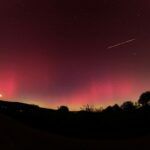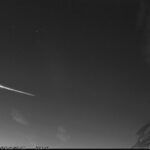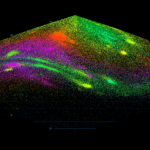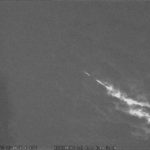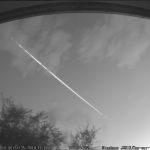The European video MeteOr Network Database (EDMOND)
 Thanks to the broad international cooperation of video meteor observers from several European countries, a multi-national network EDMONd (European viDeo Meteor Observation Network) was created. As a result of its work, the first version of the EDMOND database (European viDeo MeteOr Network Database, v2.0), containing data from the years 2009, 2010, 2011 and half of 2012, was presented at the IMC conference in La Palma, Spain in 2012 (Kornoš et al. 2013). The European video MeteOr Network Database (EDMOND) has been established only recently (Kornoš et al., 2014a,b). The cooperation between individual networks has begun in 2009, when a first orbit was being derived based on shared observations of the same meteor by CEMeNt and SVMN. In spring 2010, we contacted the Polish and Hungarian networks (PFN and HMN). First data were obtained, combined, and assessed using different detection and processing tools (UFO Tools, MetRec). In the second half of 2011, Italian stations (IMTN) were also incorporated in EDMONd for the 2011 Draconid observing campaign. This collaboration resulted in a paper presenting precise orbits of meteoroids associated with comet 21P/Giacobini-Zinner (Tóth et al. 2012). Inspired by this success, the UK network UKMON was established in 2012, which shared observing space with the French network (BOAM). In 2012, observers affiliated to the International Meteor Organization Video Meteor Network (IMO VMN) have started to share their data, whereas the data of EDMONd and IMO VMN have been merged.
Thanks to the broad international cooperation of video meteor observers from several European countries, a multi-national network EDMONd (European viDeo Meteor Observation Network) was created. As a result of its work, the first version of the EDMOND database (European viDeo MeteOr Network Database, v2.0), containing data from the years 2009, 2010, 2011 and half of 2012, was presented at the IMC conference in La Palma, Spain in 2012 (Kornoš et al. 2013). The European video MeteOr Network Database (EDMOND) has been established only recently (Kornoš et al., 2014a,b). The cooperation between individual networks has begun in 2009, when a first orbit was being derived based on shared observations of the same meteor by CEMeNt and SVMN. In spring 2010, we contacted the Polish and Hungarian networks (PFN and HMN). First data were obtained, combined, and assessed using different detection and processing tools (UFO Tools, MetRec). In the second half of 2011, Italian stations (IMTN) were also incorporated in EDMONd for the 2011 Draconid observing campaign. This collaboration resulted in a paper presenting precise orbits of meteoroids associated with comet 21P/Giacobini-Zinner (Tóth et al. 2012). Inspired by this success, the UK network UKMON was established in 2012, which shared observing space with the French network (BOAM). In 2012, observers affiliated to the International Meteor Organization Video Meteor Network (IMO VMN) have started to share their data, whereas the data of EDMONd and IMO VMN have been merged.
Narrow Field Camera (NFC)
 In 2014 a new type of narrow field, highly sensitive camera system was introduced in CEMeNt (Central European MEteor NeTwork). The system is called NFC (Narrow Field Camera). The heart of each station is a sensitive CCTV camera Watec 902 H2 Ultimate (1/2″ chip Sony ICX429ALL, sensitivity of 0.0001 lux) with fast lens Meopta Meostigmat 1/50 – 52.5 mm (focal length F=50 mm and fixed aperture f/1.0). Signal conversion of the analog output from the Watec camera to digital input to the PC is realized via USB A/D converter AverMedia DVD EZMaker or Dazzle DVC 101. Recording and evaluation of individual meteors is maintained by the software UFO Tools (UFO Capture V2, UFO Analyzer and UFO Orbit). The system is protected against weathering by a heated case Marathon MH 805/12 with IP-66. The field of view of the NFC system is 6.8° horizontally and 5.4° vertically, which is roughly 100 times smaller than conventional systems working in the BRAMON or the EDMONd networks. The limiting magnitude of NFC system during nights with average conditions is +9.5mag (stars) and +6.0mag (meteors). During nights with excellent conditions it is +10.4mag (stars) and +7.0mag (meteors). Because of the narrow field of view, standard pairing of meteor observations with wide field stations is highly improbable. Since orbit calculations for meteors captured by NFC cameras has been required, the NFC network stations are organized in stable pairs.
In 2014 a new type of narrow field, highly sensitive camera system was introduced in CEMeNt (Central European MEteor NeTwork). The system is called NFC (Narrow Field Camera). The heart of each station is a sensitive CCTV camera Watec 902 H2 Ultimate (1/2″ chip Sony ICX429ALL, sensitivity of 0.0001 lux) with fast lens Meopta Meostigmat 1/50 – 52.5 mm (focal length F=50 mm and fixed aperture f/1.0). Signal conversion of the analog output from the Watec camera to digital input to the PC is realized via USB A/D converter AverMedia DVD EZMaker or Dazzle DVC 101. Recording and evaluation of individual meteors is maintained by the software UFO Tools (UFO Capture V2, UFO Analyzer and UFO Orbit). The system is protected against weathering by a heated case Marathon MH 805/12 with IP-66. The field of view of the NFC system is 6.8° horizontally and 5.4° vertically, which is roughly 100 times smaller than conventional systems working in the BRAMON or the EDMONd networks. The limiting magnitude of NFC system during nights with average conditions is +9.5mag (stars) and +6.0mag (meteors). During nights with excellent conditions it is +10.4mag (stars) and +7.0mag (meteors). Because of the narrow field of view, standard pairing of meteor observations with wide field stations is highly improbable. Since orbit calculations for meteors captured by NFC cameras has been required, the NFC network stations are organized in stable pairs.
Meteor Spectra
 Interplanetary matter enters the Earth´s atmosphere, often in the form of small lithic rock or metallic bodies. In most cases these bodies burn in the atmosphere and are totally lost. However, during astronomical spectroscopic monitoring using spectrographs, we can keep a record of their existence and chemical composition by acquiring their emission spectra of the plasma formed during heating in the atmosphere. Our goal is to collect large sample of CCTV/CCD meteor spectra for physical/chemical characteristics of incoming material together with high quality orbits suitable for EDMOND database. The first spectroscopic observations in CEMeNt (Central European video MetEor NeTwork) network were regularly performed on experimental setup from Kroměříž during July and August 2013. Experimental mobile spectrograph was based on a highly sensitive CCD video camera Watec 902 H2 Ultimate with 1/2″ CCD chip Sony ICX 429ALL. Video was recorded in a standard PAL B signal with an effective resolution of 720 × 576 px, the sensitivity of the camera in BW mode is 0.0001 lx. The field of view was 76° × 61°, the system used a fast Goyo lens (f/1.0) with a variable focal length (3-8 mm). FOV and resolution of the CCD chip allowed the use of a holographic diffraction grating with density of 300 lines/mm, resolution of the mobile spectrograph was 56.8 Å/px.
Interplanetary matter enters the Earth´s atmosphere, often in the form of small lithic rock or metallic bodies. In most cases these bodies burn in the atmosphere and are totally lost. However, during astronomical spectroscopic monitoring using spectrographs, we can keep a record of their existence and chemical composition by acquiring their emission spectra of the plasma formed during heating in the atmosphere. Our goal is to collect large sample of CCTV/CCD meteor spectra for physical/chemical characteristics of incoming material together with high quality orbits suitable for EDMOND database. The first spectroscopic observations in CEMeNt (Central European video MetEor NeTwork) network were regularly performed on experimental setup from Kroměříž during July and August 2013. Experimental mobile spectrograph was based on a highly sensitive CCD video camera Watec 902 H2 Ultimate with 1/2″ CCD chip Sony ICX 429ALL. Video was recorded in a standard PAL B signal with an effective resolution of 720 × 576 px, the sensitivity of the camera in BW mode is 0.0001 lx. The field of view was 76° × 61°, the system used a fast Goyo lens (f/1.0) with a variable focal length (3-8 mm). FOV and resolution of the CCD chip allowed the use of a holographic diffraction grating with density of 300 lines/mm, resolution of the mobile spectrograph was 56.8 Å/px.
Acknowledgement
We would like to thank to all station owners, operators and observers for long term and precise work enabling EDMONd independent operation. Also we would like to thank to all institutions involved for still growing support of network activities.
Projects KOSOAP (Cooperating Network of Astronomic Observational Projects, in Czech: Kooperující síť v oblasti astronomických odborně-pozorovatelských programů) and RPKS (Evolvement of the Cross Border Network for Scientific Work and Education, in Czech: Rozvoj přeshraniční kooperující sítě pro odbornou práci a vzdělávání) realized by Valašské Meziříčí Observatory (CZ) and Kysuce Observatory (SK) in cooperation with with Society for Interplanetary Matter (SMPH) were co-funded by European Union (Cross-border Cooperation Programme Slovak Republic – Czech Republic 2007-2013).
The spectroscopic research has been funded by the Grant Agency of the Czech Republic (reg. no. 14-12010S) by the Programme of Regional Cooperation between the Regions and the Institutes of the Czech Academy of Sciences in 2017, (reg. no. R200401521 and reg. no. R200401721). Financial support from the Internal Fund no. 994316 of the J. Heyrovský Institute of Physical Chemistry is also greatly acknowledged.
The companies Deza, Ltd. and CS CABOT, inc., contributed for the acquisition of the instrumentation located at the Valasske Mezirici Observatory.


